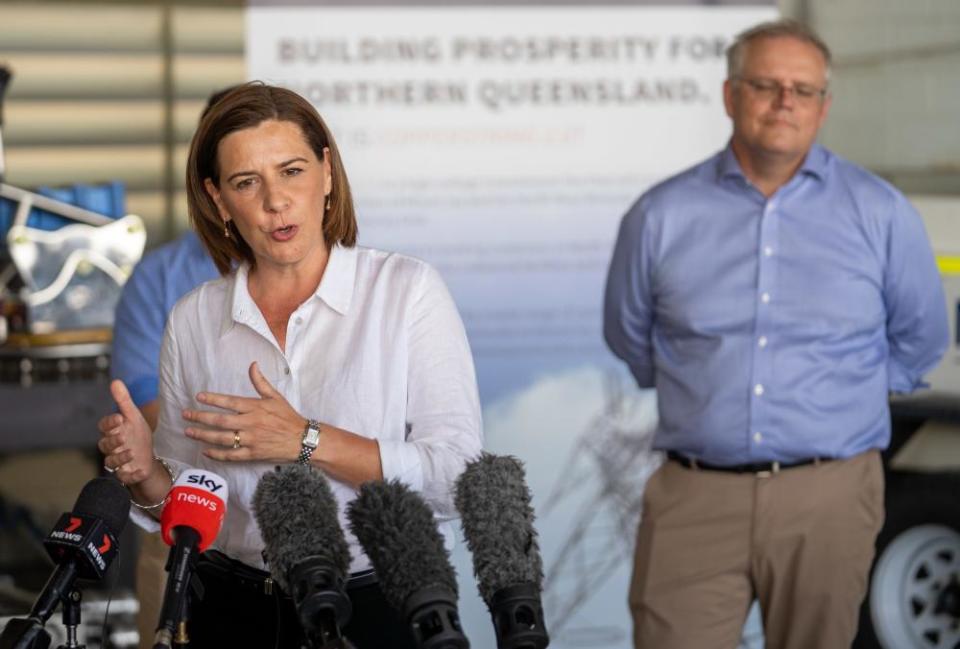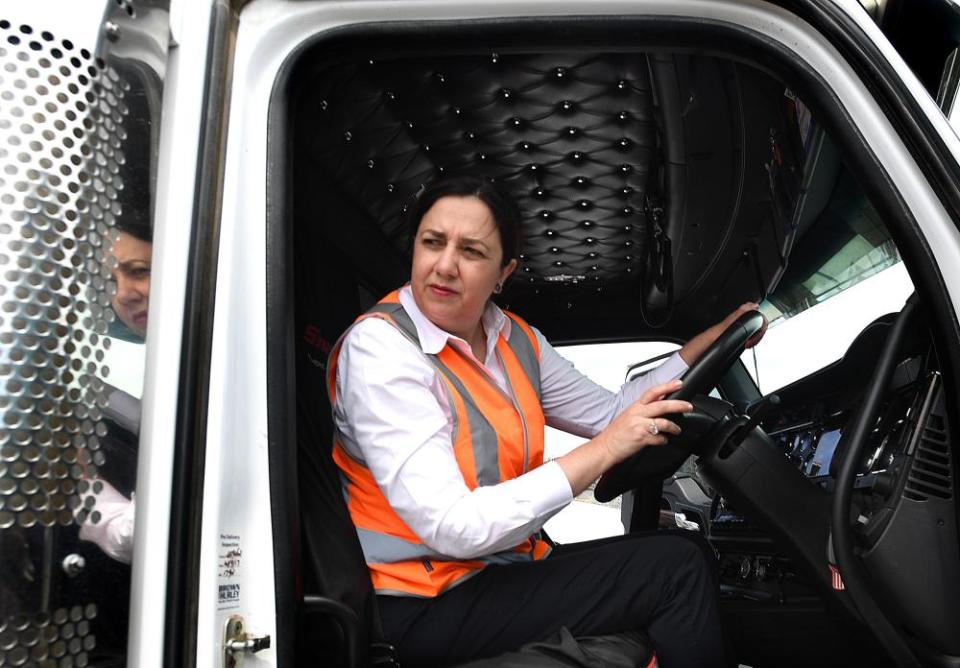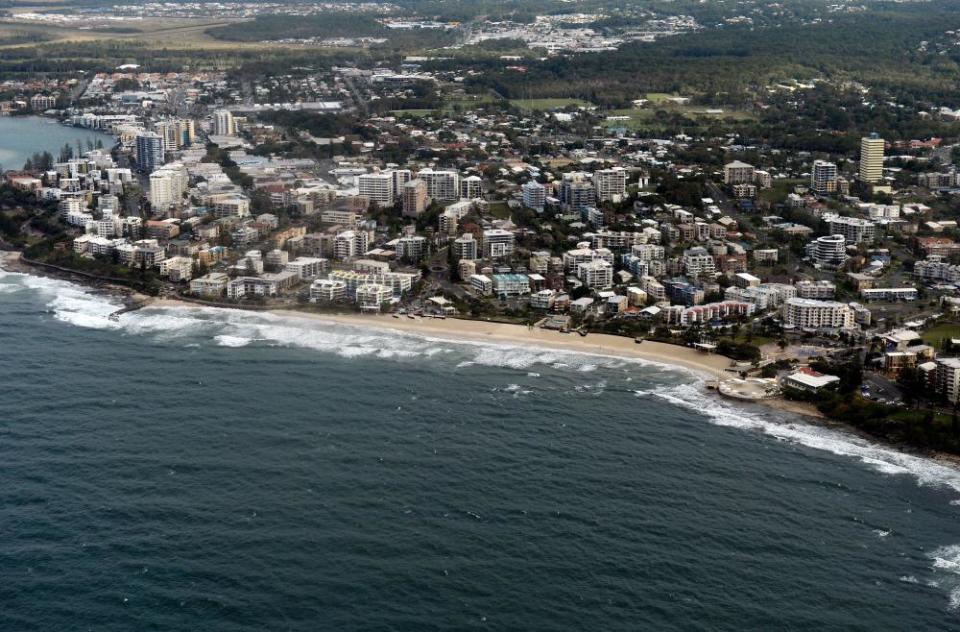Shifting sands: Queensland sees red in blue-ribbon seats as election draws near

“Caloundra is a conservative area, a strong Liberal area, I can’t see it going red,” says Shane Scriggins, a real estate agent who, after living in the southern Sunshine Coast town for 20 years, still isn’t sure he qualifies as a bona fide local.
On face value, the state electorate of Caloundra should be a blue-ribbon Liberal seat. At the last census, the median age of residents was seven years older than the rest of Queensland. The high street is dominated by hundreds of engaged small business owners.
The last time a Labor state MP was elected to represent the residents of Caloundra, in 1902, the town’s population was a few dozen people.
Yet the Queensland election campaign trail has detoured via Caloundra for the first time in decades. On Friday evening, the premier, Annastacia Palaszczuk, shared her own photographs of the Caloundra sunset through the town’s waterfront pines.
Related: 'We have to change Queensland': the environmental issues at stake in the election
“This is the changing dynamic of Queensland politics,” Glenn Kefford, a political scientist from the University of Queensland, says.
“The idea that Labor would be competitive on the Gold Coast or the Sunshine Coast, the idea they would be competitive and putting resources into those areas, it’s almost a joke to people who know Queensland.
“But what we’re seeing is there could be some significant political realignments in Queensland.”
The ‘Queensland paradox’
As Labor seeks to make incursions into Liberal National heartland, it also has to defend its own strongholds in the string of working-class regional cities spread along 1,500km of coastline, from Maryborough to Cairns.
Even in the landslide election loss of 2012, when Labor won just seven seats, the party held Mackay and Rockhampton. The first part of its election campaign has been to defend seats in regional areas, including three in Townsville, which had been considered at risk after large federal election swings to the LNP in central Queensland.
In Mackay, Labor is running Facebook ads promoting its approval of coalmines. In Brisbane, the advertising talks up its renewable energy target.
Macey, a casual retail and hospitality worker in Mackay, says her family are traditional Labor voters and will likely stick with the party.
“Honestly, I think for most of them it’s like a footy team,” she says. “Even if you’re not happy, you don’t just start supporting another team.
“Some of my friends if they are younger and work in the mines do support the Liberals. They think Labor is only really concerned with what goes on in the city.”

Maxine Newlands, a political scientist from James Cook University in Townsville, says the sorts of political messages pushed by Labor and the LNP in the northern city and other regional areas tended to reinforce binaries of “us versus them, city versus country, north versus south”.
Kefford has spoken to Guardian Australia recently about the “Queensland paradox” that requires campaigns to talk differently to voters in different parts of the state. The extension of that phenomenon is the risk that a mixed message meant for one community might cause political sands to shift elsewhere.
For instance, the Greens have sought to repurpose Labor’s pro-coalmining advertising in Mackay as a negative in Brisbane. Katter’s Australia party has targeted the LNP in the north for equivocating on coal-fired power.
Coast-to-coast strategy
Having begun the election campaign reinforcing barricades in the regions, Palaszczuk has this week pivoted to a more aggressive footing by campaigning in LNP-held marginals on the outskirts of Brisbane.
The LNP needs to gain nine seats to win government; party sources say it would be “game over” if it lost seats in Queensland’s south-east.
Related: Queensland election: LNP tries to keep anti-abortion push out of sight
On the Gold Coast, where voters typically support pro-business moderate Liberals, Labor has eyes on the seats of the LNP-held Currumbin, Bonney and Burleigh.
Steve Gration, who led the popular Save Our Spit movement on the Gold Coast, says people who move to the area tend to be Liberal voters. For instance, in the last census period, net interstate migration to the Gold Coast was highest from Sydney’s northern beaches.
“People bring with them the allegiance to the more conservative parties, but perhaps not understanding the Liberals in Victoria and New South Wales are not like the Queensland LNP,” Gration said.

Labor figures have also talked up the party’s chances in three seats at the southern end of the Sunshine Coast – Glass House, Pumicestone and Caloundra.
The most interesting – and most difficult to predict of those contests – is in Caloundra, where the well-respected local MP, Mark McArdle, is retiring. McArdle – a moderate – led the Liberal party before its merger with the Nationals to form the LNP.
When Guardian Australia spoke to locals, some, like Scriggins, dismissed the notion the area could swing to Labor.
“This is LNP heartland and we really don’t believe Palaszczuk’s team will get a look in here,” he said.
More and more people want to live [in Caloundra] and the demographic is changing rapidly
Brady Sullivan
Others point to a radical demographic shift – more than 10 families each week are moving into a massive new housing development that makes Caloundra one of the fastest-growing areas in the state. Their voting intention is largely a mystery.
Brady Sullivan, a father-of-two and the president of the Caloundra Residents Association, says an influx of 30-something families had begun to change the culture of the town as well.
“This area’s got the best beaches in Australia,” he says. “People talk to each other in the street. You’re not a local unless you’ve lived here for 30 years, but more and more people want to live here and the demographic is changing rapidly.”
Olivia Sainsbury from the local chamber of commerce, which represents 500 businesses, says the seat becoming marginal had led to long-needed promises for road and other infrastructure upgrades. Both Labor and the LNP have directed campaign resources and made significant pledges in the area.
“Voters have generally backed the LNP in for years. This new population is predominantly families and we don’t know how they’re going to vote.
“Caloundra has been very overlooked for investment so bringing a focus on to the area is something we’ve all been waiting for.”

‘Palaszczuk’s pensioners’ bring new seats into play
In the federal seat of Longman, which includes the ultra-marginal state seat of Pumicestone, two elections in 2018 and 2019 highlight the significance of older voters in the retirement belt north of Brisbane.
Labor held the seat at a 2018 byelection. A year later, the Coalition won it with a 4% swing.
“Longman was ground zero for the franking credits and the ‘death tax’ scare campaigns,” one Labor figure said.
The same cohort of older voters has been dubbed “Palaszczuk’s pensioners” within Labor’s campaign.
The conventional wisdom may be that older voters tend conservative, but the success of state border closures in suppressing the pandemic has subtly changed the dynamic of the election campaign in Labor’s favour by bringing a host of city fringe LNP seats within reach. Both parties have pitched specific policies at pensioners.
Related: Queensland election: Labor pledges to allow vote on voluntary assisted dying
Labor’s campaign launch announcement, that it would bring voluntary assisted dying laws to the parliament, was also a calculated pitch to retirees. Polls have previously found support for VAD is strongest among older voters.
The following day, the opposition leader, Deb Frecklington, announced a recycling strategy. News coverage focused on her response to Labor’s euthanasia plan.
Palaszczuk, meanwhile, was at Nerang on the Gold Coast, having a near-perfect roll at the local bowls club.
“I watched the video of that, it’s like the whole campaign distilled into 10 seconds,” an LNP member told Guardian Australia.
“Everything just falls Labor’s way. It’s mostly good fortune, but they’ve set the agenda almost every day probably since the row about who can come across the border.”


